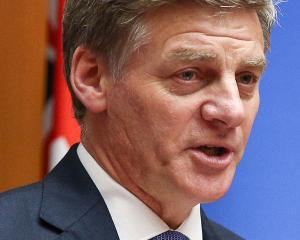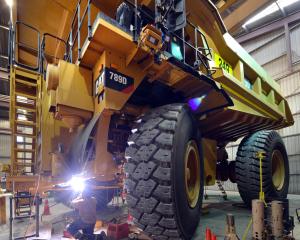Hysterical? Who's being hysterical? Not the media, Prime Minister.
If anyone is suffering from a slight touch of hysteria it is your Government.
As much as one can tell, it appears to be engaged in a frantic rewrite of a long-awaited discussion paper whose original purpose was to soften up the public to the idea of mining companies digging for dollars in the country's national parks.
If John Key really thinks the news media are getting a little hysterical, it has to be assumed the contents of the document are now relatively innocuous, to allow him to make such a quip.
However, should the final version still echo the gung-ho sentiment of Energy Minister Gerry Brownlee when he talked bullishly last August of "unlocking New Zealand's mineral potential" by means of a "stock-take" of schedule four of the Crown Minerals Act, then the Prime Minister will soon discover what true hysteria really means.
Mr Key ain't seen nothing yet.
The national debate on schedule four - the provision which blocks commercial exploitation of minerals buried in national parks, marine reserves and other areas deemed to be of "high conservation value" - has barely begun.
But the Government has already been given an early warning of what it can expect.
Using the classic slow Sunday "drop" to the media - a day when there is usually little news around - Forest and Bird knocked the Government sideways with leaked information revealing the extent of National's plans to open up land currently off limits to mining companies.
It is not the first time Kevin Hackwell, Forest & Bird's advocacy manager, has pinged a government in such a devastating manner.
In the 1980s, Mr Hackwell, operating in tandem with fellow peace activist Nicky Hager, succeeded in mobilising public opinion against the purchase of the navy's two current Anzac frigates.
The navy got its ships only because the-then Labour government was forced to buy the largely Australian-built vessels to help repair transtasman relations severely strained by New Zealand's anti-nuclear policy.
Had the public mood been the criterion, events would have taken a very different course.
The lesson for Mr Key is that he can expect one heck of a fight over mining.
Mr Hackwell is a professional when it comes to fighting such campaigns.
And he is not alone.
The conservation lobby has plenty of activists with lots of passion and energy.
It has widespread backing from many more people who choose to limit their activism to membership of conservation organisations or sympathetic political parties like Labour and the Greens.
Beyond that is an even wider group, who are sympathetic to the ideals of the conservation lobby.
And beyond that is an even larger group, for whom the sanctity of national parks is one component of the New Zealand identity.
Mr Key claimed this week that National's private polling showed more than 50% backing for mining in national parks, while the results of a Close Up phone-in poll were split 50-50 for and against.
This is politically charged territory, however.
Politicians mess with it at their peril.
Public opinion can quickly turn - something the anti-mining lobby knows implicitly and which Mr Key seems to have grasped.
Originally due last October, the discussion paper's release has been postponed several times, presumably to make its recommendations more palatable.
To justify the policy in the context of his desired "step-change" in economic growth, the Prime Minister keeps repeating the stock phrase that a balance has to be struck between the economic imperative to dramatically increase the number and range of mining operations and the Government fulfilling its environmental responsibilities.
This is public relations flim-flam.
The extraction of minerals and the protection of areas of high conservation value are mutually exclusive concepts.
You can do either one or the other.
Not both.
Mr Key would obviously disagree.
But he only needs to chat to his front-bench colleague Nick Smith, who noted the basic incompatibility as Minister of Conservation in 1997, when Schedule Four was inserted in the Crown Minerals Act.
The amending legislation, he said at the time, at long last put some "pegs in the sand" which meant New Zealand's national parks were now "no-go areas" areas for mining companies.
Nothing has changed since to give Messrs Key or Brownlee any reason beyond a newfound economic rationale to remove those pegs.
In the absence of the discussion paper and any estimates of new jobs and increased royalties, that rationale has been poorly argued.
The difficulty for Messrs Key and Brownlee is that any meaningful contribution by mining to the economic step-change is going to require opening up a lot of land to mining - something confirmed by Forest and Bird's leaked information.
A separate Cabinet paper released last year under the Official Information Act shows officials from Mr Brownlee's Ministry of Economic Development and the Department of Conservation debated repealing schedule four altogether.
That was considered too politically sensitive.
The review was adopted instead - the only concession secured by Doc, which was otherwise completely rolled by the pro-mining Med.
The political consequences of a review were ignored, however, as Med officials salivated over the possibility of mining in the Coromandel and the Kahurangi and the Paparoa national parks.
Left unanswered was the question of how mining was supposedly going to be unobtrusive in these areas, given minerals are in such low concentration that underground mining would be uneconomic.
Was National going to allow open-cast mining to have open slather in Coromandel - the closest thing Aucklanders have to a national park on their doorstep?
Those questions were raised again this week by Forest and Bird's uncovering of the Government's plans to allow mining in 7000ha of high-value conservation land in the Paparoa National Park and on Great Barrier Island and Coromandel.
The Prime Minister refused to confirm the accuracy of the leaked papers, but the amount of detail they provided, the decision to launch a State Services Commission inquiry into the leak and the fact that the material echoed the Cabinet paper released last year proved their veracity.
In the end, the Government may just tinker with schedule four by shifting small parcels of land in and out of the no-go area.
That would save some face on Mr Brownlee's behalf, while getting a thin-end-of-the-wedge slight opening of the door.
Meanwhile, the Government restores some kudos for itself by admitting it was wrong and retreating from an extreme.
In doing so, National will probably be able to bring in a much more flexible licensing regime on other land managed by Doc, on which mining has always been permitted, subject to ministerial approval.
Significantly, Mr Key alluded to the wider Conservation estate by noting the debate was not just about schedule four land and the discussion paper was likely to reflect that.
If that is the case, the Prime Minister may come up with a package which, while delighting no-one, also leaves no-one - be they miner or conservationist - none too distressed, either.





